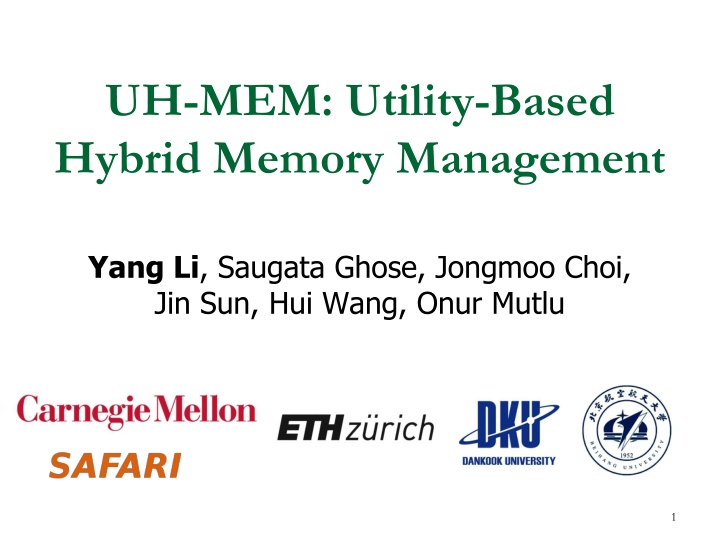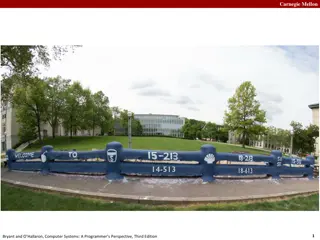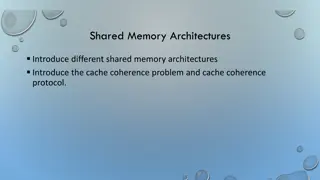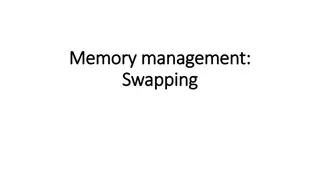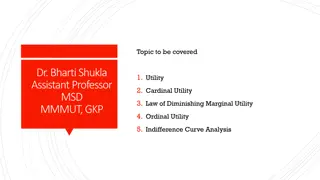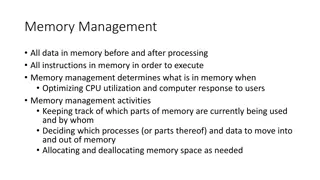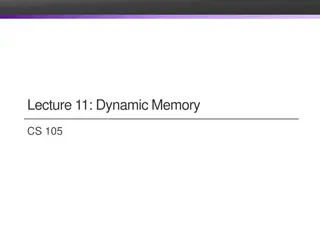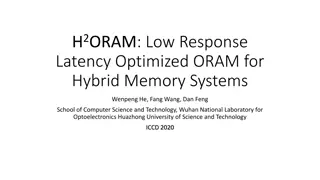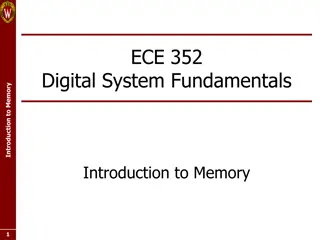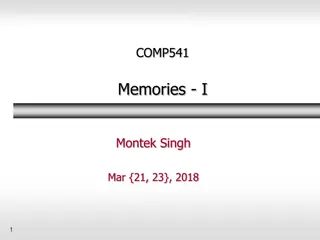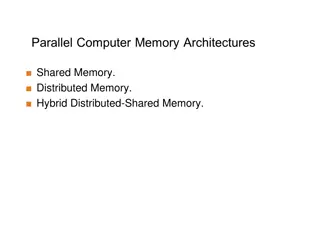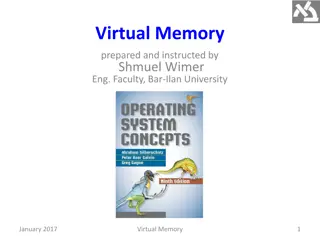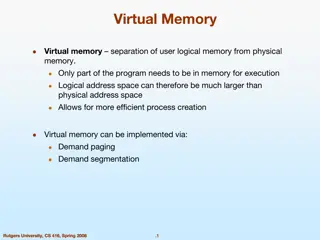UH-MEM: Utility-Based Hybrid Memory Management
The UH-MEM system addresses technology scaling challenges in DRAM by combining it with emerging memory technologies to optimize system performance. Through utility-based page placement guided by a comprehensive model, UH-MEM enhances performance by 14% on average over existing hybrid memory managers. Explore the background, key mechanisms, state-of-the-art memory technologies, and the concept of hybrid memory systems within this innovative approach.
Download Presentation

Please find below an Image/Link to download the presentation.
The content on the website is provided AS IS for your information and personal use only. It may not be sold, licensed, or shared on other websites without obtaining consent from the author.If you encounter any issues during the download, it is possible that the publisher has removed the file from their server.
You are allowed to download the files provided on this website for personal or commercial use, subject to the condition that they are used lawfully. All files are the property of their respective owners.
The content on the website is provided AS IS for your information and personal use only. It may not be sold, licensed, or shared on other websites without obtaining consent from the author.
E N D
Presentation Transcript
UH-MEM: Utility-Based Hybrid Memory Management Yang Li, Saugata Ghose, Jongmoo Choi, Jin Sun, Hui Wang, Onur Mutlu 1
Executive Summary DRAM faces significant technology scaling difficulties Emerging memory technologies overcome difficulties (e.g., high capacity, low idle power), but have other shortcomings (e.g., slower than DRAM) Hybrid memory system pairs DRAM with emerging memory technology Goal: combine benefits of both memories in a cost-effective manner Problem: Which memory do we place each page in, to optimize system performance? Processor Memory A Memory B Our approach: UH-MEM (Utility-based Hybrid MEmory Management) Key Idea: for each page, estimate utility (i.e., performance impact) of migrating page, then use utility to guide page placement Key Mechanism: a comprehensive model to estimate utility using memory access characteristics, application impact on system performance UH-MEM improves performance by 14% on average over the best of three state-of-the-art hybrid memory managers 2
Outline Background Existing Solutions UH-MEM: Goal and Key Idea Key Mechanisms of UH-MEM Evaluation Conclusion 3
State-of-the-Art Memory Technologies DRAM scaling has already become increasingly difficult Increasing cell leakage current, reduced cell reliability, increasing manufacturing difficulties [Kim+ ISCA 2014], [Liu+ ISCA 2013], [Mutlu IMW 2017], [Mutlu DATE 2017] Difficult to significantly improve capacity, speed, energy Emerging memory technologies are promising 3D-Stacked DRAM Reduced-Latency DRAM (e.g., RLDRAM, TL-DRAM) Low-Power DRAM (e.g., LPDDR3, LPDDR4) Non-Volatile Memory (NVM) (e.g., PCM, STTRAM, ReRAM, 3D Xpoint) higher bandwidth smaller capacity lower latency higher cost higher latency higher cost higher latency higher dynamic power lower endurance lower power larger capacity 4
Hybrid Memory System Pair multiple memory technologies together to exploit the advantages of each memory e.g., DRAM-NVM: DRAM-like latency, NVM-like capacity Cores/Caches Memory Controllers Channel A Channel B Memory A (Fast, Small) Memory B (Large, Slow) NVM DRAM Separate channels: Memory A and B can be accessed in parallel 5
Hybrid Memory System: Background Cores/Caches Memory Controllers Channel A Channel B Bank Row Buffer Memory A (Fast, Small) Memory B (Large, Slow) Bank: Contains multiple arrays of cells Multiple banks can serve accesses in parallel Row buffer: Internal buffer that holds the open row in a bank Row buffer hits: serviced ~3x faster, similar latency for both Memory A and B Row buffer misses: latency is higher for Memory B 6
Hybrid Memory System: Problem Cores/Caches Memory Controllers Channel A IDLE Channel B Memory A (Fast, Small) Page 1 Memory B (Large, Slow) Page 2 Which memory do we place each page in, to maximize system performance? Memory A is fast, but small Load should be balanced on both channels Page migrations have performance and energy overhead 7
Outline Background Existing Solutions UH-MEM: Goal and Key Idea Key Mechanisms of UH-MEM Evaluation Conclusion 8
Existing Solutions ALL [Qureshi+ ISCA 2009] Migrate all pages from slow memory to fast memory when the page is accessed Fast memory is LRU cache: pages evicted when memory is full FREQ: Access frequency based approach [Ramos+ ICS 2011], [Jiang+ HPCA 2010] Access frequency: number of times a page is accessed Keep pages with high access frequency in fast memory RBLA: Access frequency and row buffer locality based approach [Yoon+ ICCD 2012] Row buffer locality: fraction of row buffer hits out of all memory accesses to a page Keep pages with high access frequency and low row buffer locality in fast memory 9
Weaknesses of Existing Solutions They are all heuristics that consider only a limited part of memory access behavior Do not directly capture the overall system performance impact of data placement decisions Example: None capture memory-level parallelism (MLP) Number of concurrent memory requests from the same application when a page is accessed Affects how much page migration helps performance 10
Importance of Memory-Level Parallelism Before migration: Before migration: Mem. B requests to Page 1 requests to Page 2 Mem. B Mem. B requests to Page 3 Aftermigration: Aftermigration: requests to Page 1 Mem. A requests to Page 2 Mem. A T T requests to Page 3 Mem. A Mem. B Migrating one page reduces stall time by T Must migrate two pages to reduce stall time by T: migrating one page alone does not help time time Page migration decisions need to consider MLP 11
Outline Background Existing Solutions UH-MEM: Goal and Key Idea Key Mechanisms of UH-MEM Evaluation Conclusion 12
Our Goal A generalized mechanism that 1. Directly estimates the performance benefit of migrating a page between any two types of memory 2. Places only the performance-critical data in the fast memory 13
Utility-Based Hybrid Memory Management A memory manager that works for any hybrid memory e.g., DRAM-NVM, DRAM-RLDRAM Key Idea For each page, use comprehensive characteristics to calculate estimated utility (i.e., performance impact) of migrating page from one memory to the other in the system Migrate only pages with the highest utility (i.e., pages that improve system performance the most when migrated) 14
Outline Background Existing Solutions UH-MEM: Goal and Key Idea Key Mechanisms of UH-MEM Evaluation Conclusion 15
Key Mechanisms of UH-MEM For each page, estimate utility using a performance model Application stall time reduction How much would migrating a page benefit the performance of the application that the page belongs to? Application performance sensitivity How much does the improvement of a single application s performance increase the overall system performance? ??????? = ?????????? ???????????? Migrate only pages whose utility exceeds the migration threshold from slow memory to fast memory Periodically adjust migration threshold 16
Key Mechanisms of UH-MEM For each page, estimate utility using a performance model Application stall time reduction How much would migrating a page benefit the performance of the application that the page belongs to? Application performance sensitivity How much does the improvement of a single application s performance increase the overall system performance? ??????? = ?????????? ???????????? Migrate only pages whose utility exceeds the migration threshold from slow memory to fast memory Periodically adjust migration threshold 17
Estimating Application Stall Time Reduction Use access frequency, row buffer locality, and MLP to estimate application s stall time reduction Access frequency Row buffer locality Why not row buffer hits? Hits have equal latency in both memories, so no need to track them. Number of row buffer misses Access latency reduction for the page if migrated 18
Calculating Total Access Latency Reduction Use counter to track number of row buffer misses (#RBMiss) Calculate change in number of memory cycles if page is migrated Reduction in miss latency if we migrate from Memory B to Memory A ?????? ??????????? = #?? ???????? (???? ?, ???? ???? ?, ????) ?????? ???????????? = #?? ????????? (???? ?, ????? ???? ?, ?????) Need separate counters for reads and writes Each memory can have different latencies for reads and for writes Allows us to generalize UH-MEM for any memory 19
Estimating Application Stall Time Reduction Use access frequency, row buffer locality, and MLP to estimate application s stall time reduction Access frequency Row buffer locality Number of row buffer misses Access latency reduction for the page due to migration MLP Application stall time reduction 20
Calculating Stall Time Reduction MLP characterizes number of accesses that overlap How do overlaps affect application performance? More requests overlap reductions overlap smaller improvement from migrating the page Total number of cycles reduced for all requests ????? ????? = ?????? ??????????? ??????? + ? ?????? ???????????? ???????? Not all writes fall on critical path of execution due to write queues inside memory: p is probability that application stalls when queue is being drained Determining ??????? and ???????? for each page: Count concurrent read/write requests from the same application Amount of concurrency may vary across time use average concurrency over an interval 21
Key Mechanisms of UH-MEM For each page, estimate utility using a performance model Application stall time reduction How much would migrating a page benefit the performance of the application that the page belongs to? Application performance sensitivity How much does the improvement of a single application s performance increase the overall system performance? ??????? = ?????????? ???????????? Migrate only pages whose utility exceeds the migration threshold from slow memory to fast memory Periodically adjust migration threshold 22
Estimating Application Performance Sensitivity Objective: improve system job throughput Weighted speedup for multiprogrammed workloads Number of jobs (i.e., applications) completed per unit time [Eyerman+ IEEE Micro 2008] ??????,? ?? ????,? For each application i, ????????= ? ???? ??? ??????? = ?=1 ???????? How does each application contribute to the weighted speedup? 23
Estimating Application Performance Sensitivity Sensitivity: for each cycle of stall time saved, how much does our target metric improve by? How much of the weighted speedup did the application save in the last interval? Derived mathematically (see paper for details) ???????????? ?? ????,? ???????? ?? ????,? ????????????= = Number of cycles saved in last interval ?? ????,? can be counted at runtime ???????? can be estimated using previously-proposed models [Moscibroda+ USENIX Security 2007], [Mutlu+ MICRO 2007], [Ebrahimi+ ASLPLOS 2010], [Ebrahimi+ ISCA 2011], [Subramanian+ HPCA 2013], [Subramanian+ MICRO 2015] 24
Key Mechanisms of UH-MEM For each page, estimate utility using a performance model Application stall time reduction How much would migrating a page benefit the performance of the application that the page belongs to? Application performance sensitivity How much does the improvement of a single application s performance increase the overall system performance? ??????? = ?????????? ???????????? Migrate only pages whose utility exceeds the migration threshold from slow memory to fast memory Periodically adjust migration threshold Hill-climbing algorithm to balance migrations and channel load More details in the paper 25
Outline Background Existing Solutions UH-MEM: Goal and Key Idea Key Mechanisms of UH-MEM Evaluation Conclusion 26
System Configuration Cycle-accurate hybrid memory simulator Models memory system in details 8 cores, 2.67GHz LLC: 2MB, 8-way, 64B cache block We will release the simulator on GitHub: https://github.com/CMU-SAFARI/UHMEM Baseline configuration (DRAM-NVM) Memory latencies based on real products, prior studies Memory Timing Parameter row activation time (????) column access latency (???) write recovery time (???) precharge latency (???) DRAM 15 ns 15 ns 15 ns 15 ns NVM 67.5 ns 15 ns 180 ns 15 ns Energy numbers derived from prior works [Lee+ ISCA 2009] 27
Benchmarks Individual applications From SPEC CPU 2006, YCSB benchmark suites Classify applications as memory-intensive or non-memory- intensive based on last-level cache MPKI (misses per kilo-instruction) Generate 40 multiprogrammed workloads, each consisting of 8 applications Workload memory intensity: the proportion of memory-intensive applications within the workload 28
Results: System Performance ALL FREQ RBLA UH-MEM 1.7 Weighted Speedup 1.6 14% 1.5 Normalized 1.4 9% 1.3 1.2 5% 3% 1.1 1.0 0.9 0% Workload Memory Intensity Category 25% 50% 75% 100% UH-MEM improves system performance over the best state-of-the-art hybrid memory manager 29
Results: Sensitivity to Slow Memory Latency We vary ???? and ??? of the slow memory ALL FREQ RBLA UH-MEM 3.8 Weighted Speedup 8% 6% 3.4 14% 13% 13% 3.0 2.6 2.2 1.8 ????: ???: x3.0 x3.0 x4.0 x4.0 x4.5 x12 x6.0 x16 x7.5 x20 Slow Memory Latency Multiplier UH-MEM improves system performance for a wide variety of hybrid memory systems 30
More Results in the Paper UH-MEM reduces energy consumption, achieves similar or better fairness compared with prior proposals Sensitivity study on size of fast memory We vary the size of fast memory from 256MB to 2GB UH-MEM consistently outperforms prior proposals Hardware overhead: 42.9kB (~2% of last-level cache) Main overhead: hardware structure to store access frequency, row buffer locality, and MLP 31
Outline Background Existing Solutions UH-MEM: Goal and Key Idea Key Mechanisms of UH-MEM Evaluation Conclusion 32
Conclusion DRAM faces significant technology scaling difficulties Emerging memory technologies overcome difficulties (e.g., high capacity, low idle power), but have other shortcomings (e.g., slower than DRAM) Hybrid memory system pairs DRAM with emerging memory technology Goal: combine benefits of both memories in a cost-effective manner Problem: Which memory do we place each page in, to optimize system performance? Processor Memory A Memory B Our approach: UH-MEM (Utility-based Hybrid MEmory Management) Key Idea: for each page, estimate utility (i.e., performance impact) of migrating page, then use utility to guide page placement Key Mechanism: a comprehensive model to estimate utility using memory access characteristics, application impact on system performance UH-MEM improves performance by 14% on average over the best of three state-of-the-art hybrid memory managers 33
UH-MEM: Utility-Based Hybrid Memory Management Yang Li, Saugata Ghose, Jongmoo Choi, Jin Sun, Hui Wang, Onur Mutlu 34
Results: Fairness UH-MEM achieves similar or better fairness compared with prior proposals 35
Results: Total Stall Time UH-MEM reduces application stall time compared with prior proposals 36
Results: Energy Consumption UH-MEM reduces energy consumption for data-intensive workloads 37
Results: Sensitivity to Fast Memory Capacity UH-MEM outperforms prior proposals under different fast memory capacities 38
MLP Distribution for All Pages 20 40 20 Frequency (%) Frequency (%) Frequency (%) 15 30 15 10 20 10 5 10 5 0 0 0 0 10 20 0 10 20 0 5 10 15 MLP MLP MLP (a) soplex (b) xalancbmk (c) YCSB-B 39
Impact of Different Factors on Stall Time Correlation coefficients between the average stall time per page and different factors (AF: access frequency; RBL: row buffer locality; MLP: memory level parallelism) 42
Migration Threshold Determination Use hill climbing to determine the threshold At the end of the current period, compare ?????????????????? ?????? with ??????????????? ?????? If the system performance improves, the threshold adjustment at the end of last period benefits system performance adjust the threshold in the same direction Otherwise, adjust the threshold in the opposite direction 43
Overall UH-MEM Mechanism Period-based approach - each period has a migration threshold Action 1: Recalculate the page s utility Action 2: Compare the page s utility with the migration threshold, and decide whether to migrate Action 3: Adjust the migration threshold at the end of a quantum Adjust the migration threshold Memory Controllers Recalculate Page Utility Compare & Decide ? Memory A (Fast, Small) Memory B (Large, Slow) 44
